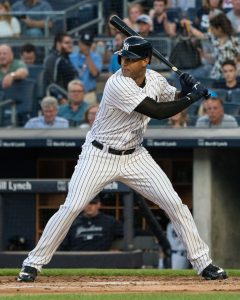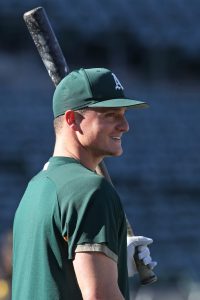The last two offseasons haven’t been too kind to the classic first base-only slugger, as teams have been increasingly less keen to spend their free agent dollars or trade assets on a player who is only viable at a single position (and the easiest position on the field to fill, at that). As Jeff Todd recently noted in his Market Snapshot of this offseason’s first base options, there are many more intriguing everyday first basemen available in trades than in free agency, though even many of the top potential trade chips carry question marks.
For instance, it isn’t clear whether or not the Diamondbacks would actually be willing to trade face of the franchise Paul Goldschmidt, or if they’ll take a less drastic approach to their offseason maneuvering. Jose Abreu has been mentioned in trade rumors for a couple of years now, though the White Sox have been unwilling to deal their clubhouse leader, plus Abreu’s stock may have dropped coming off the worst of his five MLB seasons. The likes of Brandon Belt, Wil Myers, or Carlos Santana carry pricey multi-year commitments, while other first base options might only be suited for platoon duty (i.e. Eric Thames, Justin Bour), might be too hard to acquire in a trade due to years of control (i.e. Jose Martinez), or have yet to prove themselves at the Major League level (i.e. Greg Bird, Dominic Smith).
This leaves Justin Smoak standing out as perhaps the clearest, and most decidedly available, first base upgrade of the offseason. Unlike the D’Backs or White Sox, the Blue Jays are certainly to open to all offers on their veterans, after having already unloaded much of their experienced talent last season. Contract-wise, Smoak is a fit in virtually any payroll, as he is controlled only through the 2019 season (via a club option that the Jays will certainly exercise) and at a price of just $8MM. That makes him a decidedly less expensive proposition than Belt and company, or even players like Goldschmidt ($14.5MM club option) and Abreu (a projected $16MM salary in arbitration) who are also controlled only through 2019.
Smoak’s option will bring the total value of his contract to three years and $16.25MM, and getting some good young talent back for Smoak in a trade would be the icing on the cake of what has proven to be a shrewd extension for the Jays. Once a top-ranked prospect, Smoak still hadn’t found consistency at the MLB level when the Jays acquired him off waivers from the Mariners after the 2014 season, or even when he signed that extension partway through the 2016 season. Upon taking over the everyday first base job in the wake of Edwin Encarnacion’s departure, however, Smoak has enjoyed a late-career breakout, cracking 63 homers and hitting .256/.353/.495 over 1231 PA since the start of the 2017 season.
Smoak brings no value on the basepaths (-7.3 BsR in 2018), and the advanced metrics are somewhat mixed on his fielding, as he has alternated between above-average and below-average UZR/150 and Defensive Runs Saved totals in each of the last four seasons. Beyond just that middling glovework, Smoak — who turns 32 in December — can’t play elsewhere in the field. A team in need of offense, however, could be willing to overlook these drawbacks for a switch-hitter who has created 28 percent more runs (128 wRC+) than the average big league hitter over the last two seasons.
Let’s check out which teams make sense as potential Smoak suitors this winter. After writing off the teams that are rebuilding and/or are already set at first base (Dodgers, Giants, Padres, Reds, Brewers, Cubs, Cardinals, Phillies, Nationals, Mets, Marlins, Braves, Rangers, Athletics, Royals, White Sox, Indians, Tigers, Orioles), that leaves us with…
Longshots
- Angels: They almost surely belong in the previous category since Albert Pujols and his hefty contract ($87MM remaining) are still on the books through the 2021 season. Pujols has, however, been the second-worst qualified player in baseball over the last two seasons as judged by the fWAR metric (-2.0 fWAR), and he’ll be asked to play even more first base since Shohei Ohtani will take an increasing number of DH at-bats in 2019. The thought is that the Angels will look for a part-time first baseman, though there’s at least a slim chance that they could look to acquire a regular like Smoak and relegate Pujols to the role of a highly-paid bench bat.
- Pirates: It’s too early to tell if the Bucs will make a full-fledged push to contend in 2019, and if they do, they arguably already have a first baseman in Josh Bell. Through two full seasons, however, Bell has just 1.5 fWAR total due to defensive and base-running shortcomings, plus his power numbers dropped off considerably last season. I wouldn’t expect Pittsburgh to give up early on a young and controllable player, plus the Pirates would need to carve out some payroll space elsewhere to afford Smoak.
- Diamondbacks: Well, if GM Mike Hazen plans to “be creative” with his offseason moves and doesn’t want a full rebuild, Arizona could deal Goldschmidt, and then acquire Smoak in a separate trade. This keeps first base strong for the D’Backs while also saving $6.5MM in salary. That said, this scenario is admittedly a little far-fetched.
- Yankees: Luke Voit and Bird comprise New York’s current first base options, though it wouldn’t be surprising to see Miguel Andujar in the mix if the Yankees add a more defensively-adept third baseman (hint hint). Between these internal options and more position-juggling if the Yankees re-signed Andrew McCutchen or added another outfielder, trading for Smoak seems like it would be pretty far down their list of options.
- Red Sox: Mitch Moreland is still under contract for 2019, and with J.D. Martinez locked into the DH spot, Boston is likely to just look for a right-handed hitting first baseman (potentially a re-signed Steve Pearce?) as a platoon partner rather than look for a full-timer.
Potential Suitors
- Rays: Smoak has a better track record than C.J. Cron, who the Rays are likely to cut ties with this offseason, though it isn’t clear if Smoak fits Tampa’s desire for an “impact” bat to hit from the right side of the plate (the Rays already have left-handed hitters Ji-Man Choi and Jake Bauers in the first base/DH mix). Cron was also actually slightly more productive than Smoak in 2018, with a 2.1 fWAR and 122 wRC+ to Smoak’s 1.7 fWAR and 121 wRC+, and since Smoak earns more than Cron’s projected $5.2MM arbitration salary, the Rays might want more of a substantial upgrade.
- Twins: This team has enough needs that they could take a step back to reload in 2019 rather than aim to contend. If they do decide to make a push in a weak AL Central, however, a new first baseman could be required if Joe Mauer retires.
- Astros: DH Evan Gattis and utilityman Marwin Gonzalez are scheduled for free agency, leaving a couple of holes in Houston’s lineup. Yuli Gurriel might be able to step into Gonzalez’s utility role, so even if he still gets some time at first base, it leaves room for another player like Smoak in the mix. If the Astros still have long-term plans for A.J. Reed, he wouldn’t be blocked by Smoak stepping in for just one season.
- Mariners: The first base/DH situation in Seattle is very much up in the air, considering Nelson Cruz’s free agency, Ryon Healy’s struggles in his first year with the M’s, and where the team plans to play Robinson Cano and Dee Gordon in 2019. Shifting Gordon back to his old second base spot and moving Cano into a second base/first base/DH timeshare would be a more defensively feasible, and likely wouldn’t create room for a player like Smoak unless Healy was dealt. One can’t truly rule out any scenario when it comes to trade-happy GM Jerry Dipoto, however, and bringing Smoak back to Seattle could work as a short-term fix.
- Rockies: Only the Orioles got less from their first base position than the Rockies in 2018, as Colorado first baseman combined for less than replacement-level production (-0.8 bWAR). Regular first baseman Ian Desmond could face a move back to the outfield since Gerardo Parra and Carlos Gonzalez could leave in free agency, and Ryan McMahon hasn’t shown much to prove that he could handle the position at this point in his career. The Rockies might prefer a proven veteran at first base as they look for their third consecutive postseason berth, and Smoak’s bat would be a nice addition for an overall lackluster Colorado lineup. The Rockies have the clearest need at first base of any contender, and it’s worth noting that they already linked up with the Blue Jays on one recent deal, when Seunghwan Oh was traded to Colorado last July.


